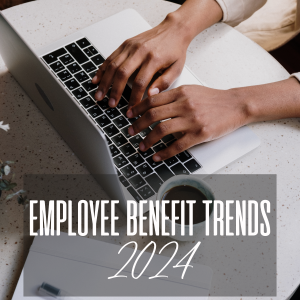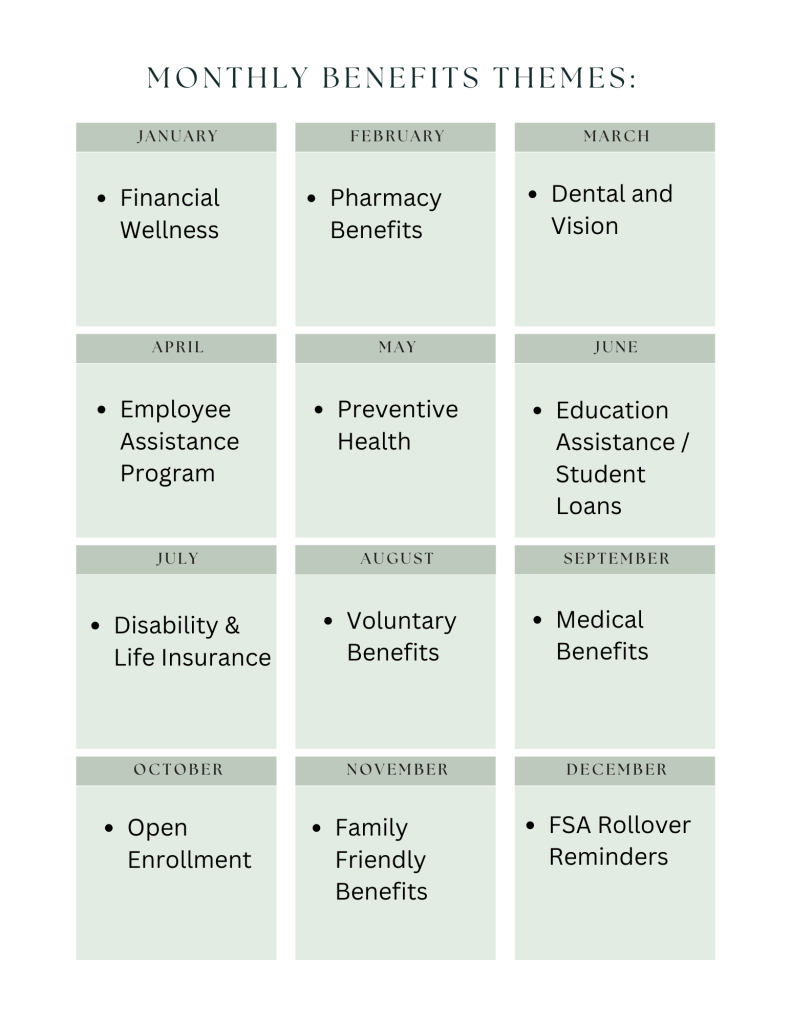
by admin | May 6, 2024 | Employee Benefits
 Life Insurance at Work: Your Guide to Voluntary Coverage
Life Insurance at Work: Your Guide to Voluntary Coverage
We all juggle life’s different responsibilities, and ensuring our loved ones are financially secure in case of our passing should be a top priority. Life insurance offers a safety net but typically the amount of coverage included as a standard company-paid life insurance policy isn’t enough to cover the financial needs of your dependents. This is where voluntary life insurance comes in – an option your employer might offer as part of your benefits package.
What is Voluntary Life Insurance?
Unlike mandatory benefits like health insurance, voluntary life insurance is an add-on you can choose. It functions similarly to regular life insurance: you pay a monthly premium, typically deducted from your paycheck, and if you pass away, a designated beneficiary receives a cash benefit.
Why Consider Voluntary Life Insurance?
Here are some key advantages:
Affordability: Because it’s a group plan, voluntary life insurance is often cheaper than individual policies. Employers may even contribute to the cost, making it even more attractive.
Convenience: Premiums are often deducted from your paycheck.
Easy Qualification: Unlike individual policies that might require medical exams, voluntary life insurance often offers guaranteed coverage, making it easier to obtain.
Additional Perks:
Some voluntary life insurance plans offer extra features like:
Coverage for Spouses and Dependents: Extend your financial protection to your family.
Portability: Continue your coverage even if you leave your job (check your specific plan details).
Accelerated Benefits: In some cases, you may access a portion of the death benefit if diagnosed with a terminal illness.
Is Voluntary Life Insurance Right for You?
While voluntary life insurance offers a convenient and affordable starting point, consider your individual needs. Think about:
Your current financial situation: Do you have existing life insurance?
Your dependents: How much would your loved ones need financially in your absence?
The coverage amount offered: Does it meet your family’s needs?
Taking the Next Step
If your employer offers voluntary life insurance, carefully review the plan details during your benefits enrollment period. Consider factors like coverage amount, available riders, and portability options. Don’t hesitate to ask your HR representative any questions you might have.
Voluntary life insurance can be a valuable tool in your financial planning. By understanding your options and weighing your needs, you can make informed decisions to ensure your loved ones are taken care of, no matter what.

by admin | May 2, 2024 | Compliance, Employee Benefits

A health plan is more than a product or service; it’s a relationship. All productive and healthy relationships—especially in the benefits space—rely on trust. When an employer extends trust in a broker or insurance carrier to purchase something as critical as healthcare—for people as critical as their workers and families—we’re obligated to raise all factors that affect that purchase.
Assisting employers with benefits compliance requires understanding key benefits laws to effectively engage, educate, and be a better partner to employer clients. The six compliance obligations listed below are just as important to check on when talking with clients about their organizational health.
1. Employee Retirement Income Safety Act (ERISA)
Dating back nearly a half century, ERISA is essentially the heart of benefits law—setting the standards of protection for employees and their families when they enroll in employer-sponsored benefit plans. Meeting those standards can cause a compliance migraine for employers—particularly when it comes to creating, updating, and distributing Summary Plan Descriptions (SPDs).
Compounding the pain, employers might think their SPD will be created by their insurance carrier or broker, but this isn’t typically the case. It’s important that employers understand their responsibility to know which benefits are subject to ERISA rules, to have these documents created through a reputable vendor or an attorney, and to adhere to ERISA’s distribution requirements.
2. Affordable Care Act (ACA)
Upheld after a contentious congressional approval and multiple Supreme Court challenges, this 2010 law changed the landscape of health insurance in many ways, not least of which was creating new compliance obligations for employers. ACA requires employers to distribute a Summary of Benefits and Coverage (SBC) to participants and beneficiaries—including enrolled, nonactive employees—plus additional requirements for ALEs (applicable large employers), those with 50 or more full-time and full-time equivalent employees.
ACA’s hidden health hazard for employers is that the law requires commonly or jointly owned businesses to count all employees together. An HR professional for one business may not know that their employer owns multiple businesses (since commonly owned businesses may not share resources like HR and benefits departments). So, asking about ALE status is an important question brokers and carriers can ask clients as a way to open the conversation about overall ACA compliance obligations.
3. Transparency in Coverage
Signed into law in 2021, the No Surprises Act builds on ACA transparency rules by requiring group health plans to:
- Post in-network negotiated rates, and out-of-network allowed amounts on a public-facing website.
- Provide a web-based price comparison tool that allows individuals to estimate their cost-sharing responsibility for a specific item/service from a particular provider.
- Annually report detailed information related to prescription drug costs, including most frequently dispersed brand-name drugs and most costly drugs.
Although fully insured plans will rely heavily on insurance carriers to make the information available, self-funded groups will bear the compliance obligations. It is critical for plan sponsors to work with carriers and third-party administrators to outline and clearly document who is responsible for each requirement.
4. Family and Medical Leave Act (FMLA)
FMLA, specifically designed to protect employees and their jobs when taking leave to care for themselves or a family member, exposes employers to compliance risk—especially as it pertains to maintaining employee health benefits.
The law requires employers to maintain an employee’s coverage, including employee contributions, as if they had not taken leave, and prohibits benefits termination while on leave except in limited circumstances.
To keep a compliance cold from turning into a full FMLA flu, broker partners must help employer clients understand their FMLA obligations, including: which benefits fall under the group health category, how to collect employee premiums while on FMLA leave, and how to provide mandatory information and notices while an employee is on FMLA leave.
5. COBRA
The Consolidated Omnibus Budget Reconciliation Act (COBRA), passed in 1985, applies to most employers with 20 or more employees that sponsor group health plans. The law is relatively straightforward, a rarity in benefits regulations.
Still, it is imperative to know help clients understand COBRA’s key provisions to effectively support them in meeting compliance obligations, including the rules for removing an ineligible dependent if an employee neglects to notify their employer for six months after a divorce is final.
6. Medicare
As employees stay in the workforce longer, employers must understand Medicare rules related to:
- Prescriptions—in particular, calculating whether their plan offers creditable coverage (compared to the standard Part D plan) and notifying Medicare-eligible employees about the creditable/non-creditable coverage calculation.
- Disclosures—specifically, preparing and submitting to CMS (Centers for Medicare and Medicaid Services) disclosure about whether the plan provides creditable coverage.
- Plan limits for cost-shifting when Medicare-eligible employees have dual coverage. The rules differ for employers with fewer than 20 employees, 20 to 99 employees, and 100 or more employees. For employers with 20 or more employees, Medicare rules limit employer plans as the primary payer from shifting an individual’s healthcare costs onto Medicare. Employers need to understand the interaction between their plan and Medicare to meet their compliance obligations.
It’s important for all parties involved to have a baseline understanding of benefits compliance obligations so they can effectively support employer clients in finding a benefits administration platform, a broker to assist with enrollment meetings, a carrier to find an in-network provider for a specialty service, and other scenarios. Compliance rules and regulations are complex. Partnering with other industry professionals, such as Mineral, is an excellent way to ensure that employer groups are educated, supported, and compliant.

by admin | Apr 8, 2024 | Employee Benefits
 No matter whether it is anticipated or unexpected, a hospital stay is expensive. According to HealthCare.gov, the average 3-day hospital stay in the United States costs around $30,000. Health insurance will cover some of the costs if you are admitted to the hospital, but you may have other out-of-pocket costs. Hospital Indemnity Insurance can help cover expenses that result from a hospital visit and unexpected emergencies.
No matter whether it is anticipated or unexpected, a hospital stay is expensive. According to HealthCare.gov, the average 3-day hospital stay in the United States costs around $30,000. Health insurance will cover some of the costs if you are admitted to the hospital, but you may have other out-of-pocket costs. Hospital Indemnity Insurance can help cover expenses that result from a hospital visit and unexpected emergencies.
What is Hospital Indemnity Insurance?
Hospital Indemnity Insurance is a supplemental insurance policy that that can be added to an existing insurance plan to cover costs due to having to stay in the hospital; it provides cash payments for hospital-related expenses. Because the money is paid directly to you, you can use the money however you want. It’s typically used to cover daily living expenses, to make up for lost income or to pay for out-of-pocket medical expenses, such as your deductible, copay or coinsurance.
Unlike medical plans, there are no deductibles to meet with a hospital indemnity plan. As soon as you incur a qualified event, you can file a claim and start receiving benefits. Hospital indemnity policies pay out a set amount of money depending on the medical service performed. With this payment model, called a fee-for-service model, you don’t have to worry about in-network versus out-of-network coverage since you receive the same payout regardless of your medical provider.
What Does a Hospital Indemnity Policy Cover?
The coverage your plan will provide depends on your plan selection but generally, most plans cover:
-
Hospital Stay (with or without surgery)
-
Intensive Care Unit (ICU) Stay
-
Critical Care Unit (CCU) Stay
Some plans may also cover:
-
Outpatient Surgery
-
Ambulances
-
Emergency Room Visits
-
Outpatient X-Ray or Diagnostic Images
Accident Insurance vs. Hospital Indemnity Insurance
The biggest difference between accident and hospital indemnity insurance is that accident coverage pays out after specific accidents, while indemnity coverage pays out after certain types of hospital stays. Both serve as supplementary health plans designed to aid with expenses not covered by your primary medical insurance.
Accident insurance pays out after a qualifying injury, such as burns, a broken arm or a laceration. Conversely, hospital indemnity coverage is triggered by specific hospital care, typically termed as inpatient hospital care. Both policies offer cash payouts that can go towards your healthcare expenses, or daily living expenses such as food and rent.

by admin | Apr 3, 2024 | Employee Benefits
 Free and low-cost employee benefits are perks that don’t cost you much financially. These perks are often simple to provide and help enhance an existing employee benefits package. Including non-traditional benefits in a job offer shows employees your values; they’re a promise to both current and potential employees that you’ll support them and treat them right.
In the competitive race for talent, employers might consider providing the following affordable employee perks to appeal to workers:
Free and low-cost employee benefits are perks that don’t cost you much financially. These perks are often simple to provide and help enhance an existing employee benefits package. Including non-traditional benefits in a job offer shows employees your values; they’re a promise to both current and potential employees that you’ll support them and treat them right.
In the competitive race for talent, employers might consider providing the following affordable employee perks to appeal to workers:
- Health Savings Accounts (HSAs) or Flexible Savings Accounts (FSAs) – Even if an organization cannot provide comprehensive healthcare benefits, providing FSAs or HSAs enables employees to allocate pre-tax funds for medical expenses, easing their financial load.
- Prioritizing Work/Life Balance – With remote work now more common as a result of the pandemic, most employees expect and appreciate greater flexibility in the workplace. In fact, 67% of people think having work/life balance is more important than their pay and employee benefits combined. Hybrid work, Paid Time Off (PTO), and flexible work hours allow employees to juggle other responsibilities, such as caring for young children or aging parents.
- Learning and Professional-Development Opportunities – Establishing a culture that supports continuous learning can help foster a mindset of growth and professional development among your workforce. Investing in professional growth opportunities, such as conferences, workshops, online courses or mentorships, demonstrates a commitment to their long-term success.”
- Mental Health Perks – Mental health is just as important as physical health and more and more employers are prioritizing it. Offering an Employee Assistance Program (EAP) that includes therapy sessions and support, mindfulness apps, and mental health days are a few ideas to encourage strong mental health.
- Paid Volunteer Time – Encouraging community engagement is possible for employers through the provision of paid time off, allowing employees to volunteer with charitable organizations. Giving back to the community not only instills a sense of purpose and fulfillment but also can strengthen team bonds.
- Employee Recognition Programs – An “emotional salary” contributes to an employee’s sense of being adequately rewarded at work, playing a significant role in job satisfaction. When employees experience a sense of value, recognition, and appreciation for their contributions, they are more likely to enjoy their work and find it meaningful. Employers can implement a system to publicly acknowledge and reward employees for their work.
- Financial Education Workshops – More employees today want guidance to increase their financial literacy. To address this demand, employers can offer resources or workshops focusing on personal finance management, budgeting, and retirement planning. Empowering employees with financial literacy can enhance overall well-being and relieve stress.
- Summer Hours and/or Casual Dress Code – Allowing casual dress on certain days allows workers to be themselves which contributes to a sense of belonging in the workplace. This could include casual Fridays or a relaxed dress code during the hot summer months. Additionally, closing an hour or two early on a Friday demonstrates flexibility and can improve employees’ work/life balance during vacation season.
You don’t need to have a fat wallet or offer more employee benefits than your competitors to win over top talent. These low or no-cost perks that employees value create a fulfilling work environment that, in turn, attracts and retains top talent!

by admin | Feb 2, 2024 | Employee Benefits
 The challenges that influenced the benefits landscape in 2023 persist—perhaps even more so. Rising costs, due to inflation and increasing health care prices, will continue to present challenges this new year. But employers who understand the benefits landscape for 2024 can mold their approach for the upcoming year.
The challenges that influenced the benefits landscape in 2023 persist—perhaps even more so. Rising costs, due to inflation and increasing health care prices, will continue to present challenges this new year. But employers who understand the benefits landscape for 2024 can mold their approach for the upcoming year.
A new year means revisiting your existing benefits strategy and looking at the top benefit trends:
Financial Wellness Benefits
Employees worry and stress about their finances and are searching for financial wellness education and guidance. Nearly 80% of employees say a financial wellness benefit is an important part of a comprehensive benefits package. Some of the popular financial wellness benefits are:
- Retirement Plan Options with Matching Contributions
- Health Savings Accounts
- Flexible Spending Accounts
- Financial Planning Assistance
- Flexible Paydays
- Employee Discount Program
- Financial Reimbursements (Ie. student loan repayment plans, child-care support funds and professional development stipends)
Voluntary Benefits
You can please some of the people some of the time, but you can’t please all the people all the time – unless you embrace voluntary benefits, that is. Voluntary benefits are optional perks that are offered to employees at a discounted group rate which their employer has negotiated with providers. While employees still need to pay to use these benefits, the amount is usually far less than it would be without company subsidies.
Moving forward, we can expect to see more sophisticated customization tools that allow employees to choose the benefits that best align with their individual circumstances and priorities. Whether it’s affordable veterinary insurance for pet owners, subsidized pre-K childcare for parents, or student loan repayment programs, offering these types of policies can directly improve the quality of life for employees who choose to take advantage of them.
Enhanced Family Benefits
Employers are increasingly looking to expand their family-friendly benefits for employees to better support employees in their caregiving roles.
- Paid family leave is not guaranteed by law in the U.S. but it is a highly sought-after perk. A parental leave policy – one that considers both parents and accounts for adoption and fostering in addition to childbirth – can show your employees you care about supporting their home lives.
- Childcare assistance supports working parents facing rising costs of living. While some larger employers may offer on-site childcare, smaller businesses can show their commitment to working parents by helping to subsidize the cost of childcare through employer contributions or pre-tax deductions.
- Fertility assistance supports employees who are going through costly infertility treatments, surrogacy, and IVF.
With four generations represented in the workforce, the support offered by employers can look different to Baby Boomers caring for their parents than a Millennial or Gen Zer caring for their children.
Inclusive and Flexible Care
The diverse workforce of 2024 is prioritizing a better work-life balance. It’s important to develop a benefits package that recognizes a healthy environment for your employees.
- Mental health benefits are in demand since mental health is a crucial part of overall health. Offering an employee assistance program (EAP) is a great way to support workers in tough situations.
- Work flexibility includes not only remote or hybrid work options, but you can also consider flexible start and stop times, a four-day work week or unlimited PTO to attract top talent and increase retention.
Overall, your benefits offerings for 2024 should reflect your organization’s values. Remember, your company depends on being able to keep your employees happy, healthy, and productive. Benefits that show respect for employees and promote a strong, vibrant culture are worth the investment.

by admin | Jan 8, 2024 | Employee Benefits
 For most organizations, employee benefits communication kicks into high gear during open enrollment season. During this time, there is a surge in emails, educational webinars, fliers throughout the office, and a barrage of forms demanding signatures.
For most organizations, employee benefits communication kicks into high gear during open enrollment season. During this time, there is a surge in emails, educational webinars, fliers throughout the office, and a barrage of forms demanding signatures.
Post open enrollment, however, employees often receive minimal information about their benefits. While sporadic email updates or new laminated signs in the office kitchen may occur, a comprehensive, year-round employee benefits communication plan is often lacking.
This oversight represents a significant missed opportunity. An annual approach is insufficient to ensure that employees genuinely comprehend and effectively utilize their benefits.
When employers use a year-round approach to fully educate their employees on their benefits offerings, employees benefit both in their personal well-being and financial security. Employers also benefit from increased employee engagement, leading to a more creative work environment, reduced stress levels, higher employee retention rates, and potentially higher profitability. Establishing a year-round employee benefits communication plan is crucial.
One way to establish an engaging year-round employee communication plan is through a calendar-based approach. Creating a monthly or quarterly calendar allows for the concentration on a series of topics related to benefits throughout the year. Q4 is the optimal period to highlight open enrollment, while the remaining three quarters provide an opportunity to dive into specific benefit categories such as health, lifestyle, and wealth.
Think about what will be on the top of employee’s minds over the next several months and create a calendar that speaks to those needs. Here is an example of a quarterly calendar:
Q1: In the beginning of the new year, the mantra is “New Year, New You!” What benefits can help employees plan for their future throughout the year – and take the stress out of the decision-making process?
Q2: With the weather beginning to warm up and the beginning of spring, many employees start to be more active and spend more time outdoors. What benefits address overall health and well-being?
Q3: Summertime means vacations for many families. This is a good time to address a healthy work-life balance and to give reminders about time off and childcare benefits.
Q4: When the weather starts to turn cooler, Q4 is in full gear! And that means one thing: Open Enrollment Season. Do your employees have the information to help them pick the right plan for the upcoming year?
Here is an example of some themes to incorporate into a monthly calendar:

Benefits education is communicating information about available benefits in ways that employees can connect to and understand. Communicating benefits information year-round is important because employees’ lives – and their situations – are constantly changing. They get married, divorced, adopt a child or have medical challenges arise. They are thinking about their health and financial security and how to adapt to it. If employees are engaged with their benefits throughout the year, they are more likely to value and use their benefits and will be better informed about their decisions and/or changes they need to make during the next Open Enrollment period!

 Life Insurance at Work: Your Guide to Voluntary Coverage
Life Insurance at Work: Your Guide to Voluntary Coverage





